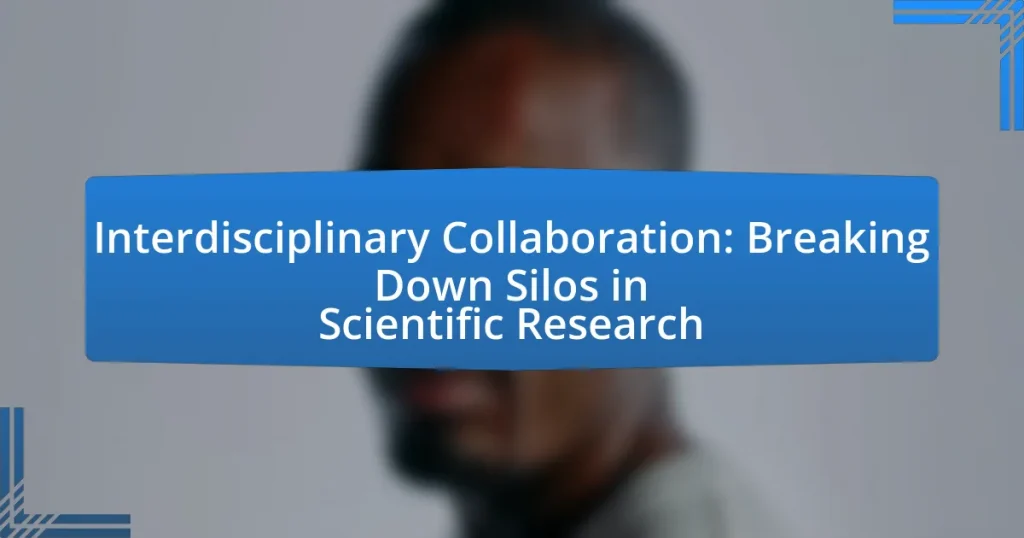Interdisciplinary collaboration in scientific research involves the cooperative efforts of experts from various fields to tackle complex problems that cannot be addressed by a single discipline. This approach enhances innovation and creativity, leading to more comprehensive solutions and higher-impact research outcomes. The article explores the differences between interdisciplinary collaboration and traditional research methods, key characteristics of successful collaboration, challenges faced, and the essential role of communication and institutional culture. It also highlights the benefits of interdisciplinary collaboration, including improved problem-solving capabilities and advancements in scientific education, while providing practical strategies for effective implementation and common pitfalls to avoid.

What is Interdisciplinary Collaboration in Scientific Research?
Interdisciplinary collaboration in scientific research refers to the cooperative effort among experts from different fields to address complex problems that cannot be solved by a single discipline alone. This approach enhances innovation and creativity by integrating diverse perspectives, methodologies, and expertise, leading to more comprehensive solutions. For instance, a study published in the journal “Nature” highlights that interdisciplinary teams can produce higher-impact research outcomes, as evidenced by increased citation rates and broader applicability of findings across various domains.
How does Interdisciplinary Collaboration differ from traditional research methods?
Interdisciplinary collaboration differs from traditional research methods by integrating diverse fields of expertise to address complex problems, whereas traditional methods typically focus on a single discipline. This collaborative approach fosters innovation and creativity, as it combines various perspectives and methodologies, leading to more comprehensive solutions. For instance, a study published in the journal “Nature” highlights that interdisciplinary teams are more effective in tackling global challenges like climate change, as they leverage knowledge from environmental science, economics, and social sciences, resulting in more holistic strategies. In contrast, traditional research often remains siloed, limiting the scope and applicability of findings.
What are the key characteristics of Interdisciplinary Collaboration?
Interdisciplinary collaboration is characterized by the integration of diverse expertise and perspectives to address complex problems. This collaboration involves effective communication among team members from different disciplines, fostering mutual respect and understanding of each other’s methodologies. Additionally, it emphasizes shared goals and objectives, which align the efforts of various specialists towards a common outcome. Research indicates that interdisciplinary teams often produce more innovative solutions, as they leverage the unique strengths of each discipline, leading to enhanced creativity and problem-solving capabilities. For instance, a study published in the journal “Nature” highlights that interdisciplinary research teams are more likely to generate high-impact publications compared to single-discipline teams, demonstrating the effectiveness of this collaborative approach.
Why is Interdisciplinary Collaboration essential in modern science?
Interdisciplinary collaboration is essential in modern science because it fosters innovation and addresses complex problems that cannot be solved within the confines of a single discipline. By integrating diverse perspectives and expertise, researchers can develop comprehensive solutions to multifaceted challenges, such as climate change and public health crises. For instance, the National Academy of Sciences emphasizes that interdisciplinary approaches lead to breakthroughs in understanding and technology, as seen in the development of new medical treatments that combine insights from biology, engineering, and data science. This collaborative framework not only enhances the quality of research but also accelerates the pace of scientific discovery, making it crucial for advancing knowledge and societal progress.
What are the main challenges of Interdisciplinary Collaboration?
The main challenges of interdisciplinary collaboration include communication barriers, differing terminologies, and conflicting methodologies. Communication barriers arise when team members from different disciplines struggle to convey their ideas effectively, often due to a lack of shared language or understanding. Differing terminologies can lead to misunderstandings, as professionals may use the same terms to mean different things in their respective fields. Conflicting methodologies present another challenge, as each discipline may have its own established practices and standards, making it difficult to integrate approaches. These challenges can hinder the effectiveness of collaborative efforts and limit the potential for innovative solutions in scientific research.
How do communication barriers affect collaboration among disciplines?
Communication barriers significantly hinder collaboration among disciplines by creating misunderstandings and reducing the effectiveness of information exchange. When professionals from different fields struggle to comprehend each other’s terminology, concepts, or methodologies, it leads to misaligned goals and decreased productivity. For instance, a study published in the Journal of Interprofessional Care found that 70% of interdisciplinary teams reported challenges due to differing professional languages, which directly impacted their collaborative outcomes. This evidence illustrates that effective communication is crucial for successful interdisciplinary collaboration, as it fosters mutual understanding and facilitates the integration of diverse perspectives.
What role does institutional culture play in fostering or hindering collaboration?
Institutional culture significantly influences collaboration by either promoting or obstructing cooperative efforts among individuals and teams. A culture that values open communication, shared goals, and mutual respect fosters an environment conducive to collaboration, as evidenced by studies showing that organizations with strong collaborative cultures report higher levels of innovation and productivity. Conversely, a culture characterized by rigid hierarchies, lack of trust, and siloed departments hinders collaboration, leading to fragmented efforts and reduced effectiveness in achieving interdisciplinary objectives. For instance, research published in the Journal of Organizational Behavior highlights that organizations with supportive cultures experience 30% more successful collaborative projects compared to those with restrictive cultures.

What are the benefits of Interdisciplinary Collaboration?
Interdisciplinary collaboration enhances innovation and problem-solving by integrating diverse perspectives and expertise. This collaborative approach allows teams to tackle complex challenges more effectively, as evidenced by research showing that interdisciplinary teams produce higher-quality outcomes in scientific research. For instance, a study published in the journal “Nature” found that interdisciplinary collaborations led to a 20% increase in the impact of research publications, demonstrating the tangible benefits of combining knowledge from different fields.
How does Interdisciplinary Collaboration enhance innovation in research?
Interdisciplinary collaboration enhances innovation in research by integrating diverse perspectives and expertise, which fosters creative problem-solving and novel approaches. When researchers from different fields collaborate, they combine their unique methodologies and knowledge bases, leading to breakthroughs that may not occur within a single discipline. For instance, a study published in the journal “Nature” by Wuchty, Jones, and Uzzi in 2007 found that interdisciplinary teams produce more impactful research, as measured by citation rates, compared to those working within a single field. This evidence demonstrates that such collaboration not only broadens the scope of inquiry but also accelerates the pace of innovation in scientific research.
What examples illustrate successful outcomes from Interdisciplinary Collaboration?
Successful outcomes from interdisciplinary collaboration include the Human Genome Project, which involved geneticists, biologists, and computer scientists working together to map the entire human genome, resulting in significant advancements in genetics and medicine. Another example is the collaboration between engineers and medical professionals in developing advanced prosthetics, leading to improved functionality and quality of life for amputees. Additionally, the integration of environmental scientists and urban planners in sustainable city design has resulted in innovative solutions for urban sustainability, enhancing both ecological health and community well-being. These examples demonstrate how diverse expertise can lead to groundbreaking advancements across various fields.
How can diverse perspectives lead to more comprehensive solutions?
Diverse perspectives lead to more comprehensive solutions by integrating varied experiences, knowledge, and methodologies, which enhances problem-solving capabilities. When individuals from different disciplines collaborate, they bring unique insights that can identify blind spots and challenge assumptions, ultimately leading to innovative approaches. For instance, a study published in the journal “Nature” found that interdisciplinary teams are 1.5 times more likely to produce high-impact research compared to homogeneous groups, demonstrating that diversity fosters creativity and effectiveness in addressing complex issues.
What impact does Interdisciplinary Collaboration have on scientific education?
Interdisciplinary collaboration significantly enhances scientific education by fostering a comprehensive understanding of complex problems through diverse perspectives. This collaborative approach encourages students to integrate knowledge from various fields, leading to innovative solutions and critical thinking skills. Research indicates that programs emphasizing interdisciplinary learning improve student engagement and retention rates, as evidenced by a study published in the Journal of Higher Education, which found that students involved in interdisciplinary projects reported higher satisfaction and academic performance.
How can educational institutions promote Interdisciplinary Collaboration among students?
Educational institutions can promote interdisciplinary collaboration among students by implementing project-based learning that requires teamwork across different fields of study. This approach encourages students from diverse academic backgrounds to work together on real-world problems, fostering communication and shared knowledge. Research indicates that project-based learning enhances critical thinking and problem-solving skills, as evidenced by a study published in the Journal of Educational Psychology, which found that students engaged in interdisciplinary projects showed a 30% increase in collaborative skills compared to traditional learning methods. Additionally, institutions can facilitate interdisciplinary workshops and seminars that bring together experts from various disciplines, allowing students to gain insights and collaborate on innovative solutions.
What skills are essential for effective collaboration in scientific research?
Effective collaboration in scientific research requires strong communication skills, teamwork, and adaptability. Communication skills enable researchers to convey complex ideas clearly and facilitate discussions among diverse team members. Teamwork is essential as it fosters a cooperative environment where individuals contribute their expertise towards a common goal. Adaptability allows researchers to adjust to new information, methodologies, and perspectives, which is crucial in interdisciplinary settings. These skills are supported by studies indicating that effective communication and collaboration significantly enhance research outcomes and innovation in scientific projects.

How can we effectively implement Interdisciplinary Collaboration?
To effectively implement interdisciplinary collaboration, organizations should establish clear communication channels and shared goals among diverse teams. This approach fosters mutual understanding and aligns objectives, which is essential for successful collaboration. Research indicates that interdisciplinary teams that engage in regular meetings and utilize collaborative tools report higher satisfaction and productivity levels. For instance, a study published in the journal “Nature” found that interdisciplinary research teams are 50% more likely to produce impactful publications when they have structured communication practices in place. Therefore, prioritizing communication and goal alignment is crucial for effective interdisciplinary collaboration.
What strategies can organizations adopt to facilitate Interdisciplinary Collaboration?
Organizations can adopt several strategies to facilitate interdisciplinary collaboration, including establishing cross-functional teams, promoting open communication, and providing shared resources. Cross-functional teams bring together individuals from diverse disciplines, fostering a collaborative environment that encourages the exchange of ideas and expertise. Open communication channels, such as regular meetings and collaborative platforms, enhance transparency and ensure that all team members are aligned on goals and progress. Additionally, providing shared resources, such as access to databases and collaborative tools, enables team members to work more efficiently and effectively across disciplines. These strategies have been shown to improve innovation and problem-solving capabilities, as evidenced by studies indicating that interdisciplinary collaboration leads to more comprehensive solutions in complex research areas.
How can technology support collaborative efforts across disciplines?
Technology can support collaborative efforts across disciplines by providing platforms for communication, data sharing, and project management. These platforms, such as cloud-based tools and collaborative software, enable researchers from different fields to work together in real-time, facilitating the exchange of ideas and resources. For instance, tools like Slack and Microsoft Teams allow for instant messaging and video conferencing, while platforms like Google Drive and Dropbox enable easy access to shared documents and datasets. Research shows that interdisciplinary teams leveraging technology can enhance innovation and problem-solving capabilities, as evidenced by a study published in the journal “Nature” which found that collaborative projects often yield higher-impact publications compared to single-discipline efforts.
What role do leadership and management play in fostering collaboration?
Leadership and management play a crucial role in fostering collaboration by creating an environment that encourages teamwork and open communication. Effective leaders set a vision that aligns team goals, while managers implement structures and processes that facilitate collaboration across disciplines. For instance, research by the National Academy of Sciences highlights that leadership styles that promote inclusivity and shared decision-making significantly enhance collaborative efforts in scientific research. This evidence underscores the importance of leadership and management in breaking down silos and enabling interdisciplinary collaboration.
What are some best practices for successful Interdisciplinary Collaboration?
Successful interdisciplinary collaboration requires clear communication, mutual respect, and defined roles among team members. Establishing open lines of communication ensures that all participants can share ideas and feedback effectively, fostering an environment of trust and understanding. Mutual respect for each discipline’s expertise encourages collaboration and innovation, as team members feel valued and empowered to contribute. Clearly defined roles and responsibilities help to streamline efforts and minimize confusion, allowing the team to focus on shared goals. Research indicates that teams with these practices are more likely to achieve successful outcomes, as evidenced by a study published in the journal “Nature” which found that interdisciplinary teams produce higher-quality research outputs.
How can teams establish clear goals and expectations for collaboration?
Teams can establish clear goals and expectations for collaboration by implementing structured communication strategies and defining specific, measurable objectives. Structured communication, such as regular meetings and collaborative platforms, ensures that all team members are aligned on project goals and responsibilities. Defining specific objectives, such as deadlines and deliverables, provides clarity and accountability. Research indicates that teams with well-defined goals are 20-25% more effective in achieving project outcomes, as evidenced by a study published in the Journal of Applied Psychology, which highlights the correlation between goal clarity and team performance.
What methods can be used to evaluate the effectiveness of collaborative projects?
To evaluate the effectiveness of collaborative projects, methods such as surveys, performance metrics, and case studies can be employed. Surveys can gather qualitative and quantitative feedback from participants regarding their experiences and perceived outcomes. Performance metrics, including project completion rates, budget adherence, and timeline accuracy, provide objective data on project success. Case studies offer in-depth analysis of specific collaborative efforts, highlighting best practices and lessons learned. These methods collectively enable a comprehensive assessment of collaboration effectiveness, supported by empirical data and participant insights.
What common pitfalls should be avoided in Interdisciplinary Collaboration?
Common pitfalls to avoid in interdisciplinary collaboration include poor communication, lack of shared goals, and insufficient understanding of different disciplines. Poor communication can lead to misunderstandings and misalignment, which hinders progress. A lack of shared goals results in team members working in silos rather than collaboratively, diminishing the effectiveness of the project. Insufficient understanding of different disciplines can create barriers to collaboration, as team members may not appreciate the value or methods of others’ expertise. Research by Klein (2010) in “A Taxonomy of Interdisciplinary Collaboration” highlights that these pitfalls can significantly impact the success of collaborative efforts in scientific research.
How can misunderstandings be minimized among team members from different disciplines?
Misunderstandings among team members from different disciplines can be minimized through effective communication strategies. Establishing regular meetings that encourage open dialogue allows team members to clarify their perspectives and expectations. Additionally, using a common language or terminology can bridge gaps in understanding, as evidenced by a study published in the Journal of Interprofessional Care, which found that shared vocabulary significantly improved collaboration outcomes. Implementing collaborative tools and platforms also facilitates real-time information sharing, reducing the likelihood of misinterpretation.
What are the consequences of inadequate planning in collaborative research?
Inadequate planning in collaborative research leads to miscommunication, project delays, and inefficient resource allocation. Miscommunication among team members can result in conflicting objectives and misunderstandings about roles, which hinders progress. Project delays often occur due to a lack of clear timelines and milestones, causing frustration and potential loss of funding. Additionally, inefficient resource allocation can arise when teams do not effectively coordinate their efforts, leading to duplicated work or underutilization of skills. These consequences ultimately compromise the quality and impact of the research outcomes.
What practical tips can enhance Interdisciplinary Collaboration in scientific research?
To enhance interdisciplinary collaboration in scientific research, establish clear communication channels among team members. Effective communication fosters understanding of diverse perspectives and expertise, which is crucial for collaborative success. Regular meetings and collaborative platforms, such as shared digital workspaces, can facilitate ongoing dialogue and idea exchange. Additionally, defining common goals and objectives ensures that all team members are aligned and working towards the same outcomes. Research indicates that teams with well-defined roles and responsibilities experience higher productivity and satisfaction, as seen in studies published in the Journal of Interdisciplinary Research.


